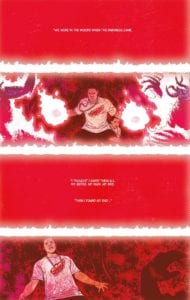I can say, without a doubt, that The Wicked + The Divine stands tall as my favourite title from Image Comics. I would go as far as saying it’s a close third to Dark Horse‘s Hellboy and Vertigo‘s The Sandman. But for all my undying love, I cannot presume to claim it’s easy to talk about this comic book, let alone write about it. And for all my consistent enjoyment, I must acknowledge when Kieron and Jamie (The Godly Daddies, I call them) make a decision which may encounter a mixed response. All in all, reviewing Twin Peaks: The Return got me accustomed to these exercises of candour.
Not gonna lie here, lovelies. This may be a somewhat shorter reread-and-review than usual out of the issue’s very construction. Some may either call it a lazy one, or a peculiar kind of brilliant exploit – the kind only people like Kieron and Jamie can get away with. Regardless of any possible controversy, do I think this is a worthwhile issue?
Absolutely. Especially if you love horrendous revelations. If you’ve stuck with us so far, I’m gonna take that as a “Yes, I am very much into that.”
Issue #36
“It’s all I’ve ever wanted.”
The coherence of the Mothering Invention arc is simple enough: insightful revelation of stuff we didn’t know before. The mysteries surrounding Ananke become a bit more grounded on certain intention. Plus, we set some light unto the dark in which she has kept the Pantheon as us readers. Getting a proper well-handled look at the origins of a paradigm is a boon on its own. We shouldn’t really expect the history between then and now to unfold before our eyes when extrapolation on the reader’s behalf will occur organically. But that’s just what we get with the unveiling of the First Recurrence’s Persephone (the lovely woman gracing the cover) in Egypt, 3862 BC, and her immediate murder via Ananke.
Quite the familiar scene, isn’t it? We all know the adage that “history tends to repeat itself”. Well, almost as if to sarcastically mock the saying, we get a reprisal of the same dynamic across fourteen pages. The gimmick, as you can see below, is to have the scene’s basic construction reprised sixfold each page. However, in my personal opinion, this device is more clever than it would be lazy as the structuring is both tragic and even comedic. Furthermore, each scene features considerable variations; not only to match the time, place and culture, but also to detail how Ananke has changed her M.O. As some would-be victims played smart and thwarted her attempts, Ananke has started to disguise her intentions, opting for a subtler, duplicitous approach.

Mind you, the subversions and inversions in Ananke’s pattern leaves plenty of room for nice stories. Fanfiction writers, if you may… Anyway, this progression essentially shapes Ananke to the form we know. The final panel after her 2014 attempt to claim Persephone’s head shows her comforting a Minerva whose expression looks quite undecipherable.
Gimmick over, the story progresses as usual, picking up at that awkward little impasse between Persephone and Baal (Hammon). The latter gets on with the explaining by narrating (and flashback-ing) the state of affairs when he ascended as the first God of this Recurrence. It’s as glamorous as we’ve come to know if from other ascensions, but this one featured something else. Warning him about the Great Darkness, she fretfully reveals a sacrifice is required to keep it at bay: a child. Naturally, Baal refuses, earning an award winning performance on Ananke’s behalf for preemptive tearful mourning.

Then the Great Darkness did come, for his family especifically. Although he managed to save his mother and his siblings, his father succumbed. Ater cremating his father himself, Baal gave in to ‘necessity’ that very night. By now, ‘unreliable narrator’ is a major understatement when it comes to Ananke. But I’m not sure we can elevate Baal to that same degree at the moment. He’s likely still in useful-pawn territory. Regardless, in order to repel the enigmatic evil, Baal has taken to performing a sacrifice every four months. This is most likely also at Ananke’s instruction.
The reason? Probably to keep Baal yoked to her design. If we go by my personal interpretation that The Great Darkness is a phenomenon she trusted Woden (and Mimir) with creating, she has been manipulating events in order to keep a few Gods loyal to her by making fear and necessity one and the same. It’s masterful, evil PR right here if true. Otherwise, feel free to deem me a fool. Regardless, this zeal unveils the disturbing manner of Baal’s “Imperial Phase”. In order to defend this cause, he looks ready enough to kill Laura. Her brief inner monologue ensues, detailing an ambivalence to whether she wants to live or die. The crux of this conflict sits at the bottom of her stomach.
It’s then she releases the anvil. She’s three months pregnant. No knowledge on who’s the father. I mean, if there was a time to drop that revelation, it’s now. And it’s a somewhat predictable bombshell. But it still works well. Both as a narrative device and to let her off the fiery hook. Baal tells her then to leave as he annihilates Valhalla in a blaze. It’s a sour kind of end we get for this wicked den of divinity. Especially given how badass Rising Action was. But even the seemingly anti-climatic carries a weight of its own.
We don’t know if Baal is still alive. That’s one of the many questions pending for next issue, and for the unknown sender of the latest message in Laura’s phone. It’s probably Minerva. The message, however, does begs the question: Who really remains alive in this gig anymore? All aboard the Doom Express, the final destination draws near.

The Wicked + The Divine Issue #36 Credits
Writer: Kieron Gillen
Art / Cover: Jamie McKelvie
All images are courtesy of Image Comics

